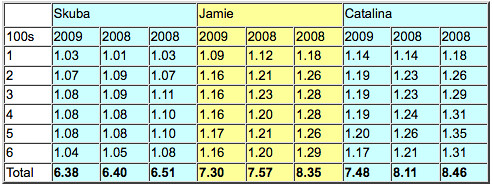By David
Last week, an American swim coaching magazine spent several pages discussing distance. In case youтАЩre not familiar with the concept of distance, IтАЩve used the mathematical formula as the title to this article. I happen to be a strong supporter of distance: not the formula, but distance training. No one who has been an Arthur Lydiard disciple for as long as I have could be anything else.
Our team has just completed their ten week aerobic conditioning build up in preparation for the 2009 summer season. The table below shows the distances several swimmers covered each week and their total for the period.
 SkubaтАЩs 880 kilometers is a long way to swim. ItтАЩs not the best IтАЩve seen. Both Toni Jeffs and Jane Copland got through 1000 kilometers in the ten weeks. Jane did it on several occasions [Editor’s note: I think it was only twice :)]. However, 880 kilometers is certainly world class distance conditioning. The lost 50 kilometers in week five, when Skuba was ill with a flu type bug that went around the team, cost him the chance of a build up in excess of 900 kilometers. This build up was SkubaтАЩs first attempt at a full tens and was a very good effort. It will yield beneficial physiological changes that will result in faster swim times; but more of that later.
SkubaтАЩs 880 kilometers is a long way to swim. ItтАЩs not the best IтАЩve seen. Both Toni Jeffs and Jane Copland got through 1000 kilometers in the ten weeks. Jane did it on several occasions [Editor’s note: I think it was only twice :)]. However, 880 kilometers is certainly world class distance conditioning. The lost 50 kilometers in week five, when Skuba was ill with a flu type bug that went around the team, cost him the chance of a build up in excess of 900 kilometers. This build up was SkubaтАЩs first attempt at a full tens and was a very good effort. It will yield beneficial physiological changes that will result in faster swim times; but more of that later.
Just as impressive was the build up by 12-year-old Jamie. An average of 66 kilometers a week for ten weeks at 12 is the best IтАЩve seen from a swimmer of her age. An average of 58 kilometers by the other twelve year old, Catalina, is the second best IтАЩve seen. Whoever said young swimmers couldnтАЩt swim these distances never saw these two girls. Part way through the build up JamieтАЩs Dad was officiating at a local swim meet. One of the officials from another club asked him how far his daughter swam each week. JamieтАЩs Dad said, тАЬAbout 70 kilometers.тАЭ The official said that was clearly a mistake. No 12 year old could swim that sort of distance. Our incredulous friend probably does not read Swimwatch, but if he does, she sure as hell can.
On the final Saturday of each seasonтАЩs build up I set the team a 600 meter time trial as a test of their aerobic conditioning. Obviously, after all that long distance training swimmers are in no shape to race fast. They should however be aerobically fit enough to swim 600 meters at a good pace with even 100 meter splits. I look for two things in this trial session. Has the overall time improved from the same swim last season and are the splits for each 100 even? The table below shows the total and split times for the last three 600 trials swum by three of the swimmers.
 It may be of interest to see the result of a 600 meter breaststroke trial that I thought was pretty impressive. Jane swam it at the end of a 1000 kilometer build up and about twelve weeks before she won her first New Zealand national championship and broke her first New Zealand open record.
It may be of interest to see the result of a 600 meter breaststroke trial that I thought was pretty impressive. Jane swam it at the end of a 1000 kilometer build up and about twelve weeks before she won her first New Zealand national championship and broke her first New Zealand open record.

When it comes to distance conditioning, obviously I agree with Councilman and Lydiard. For those who may have doubts consider these factors:
- In JaneтАЩs 600 meter breaststroke trial she swam 2.38 for the first 200 meters and 2.39 for the last 200 meters. ThatтАЩs a pretty good sign of sound, deep seated aerobic fitness.
- A 12 year old female whose best race times before this build up were, 100 meters 1.12, 200 meters 2.35 and 400 meters 5.08 swam these distances during this 600 trial in 1.09, 2.25 and 4.57. ThatтАЩs another pretty good sign of improved aerobic fitness.
- Skuba swam his first trial a year ago after having three years away from the sport. Two more build ups and this trial was 3% faster. That too is a pretty good sign of improved aerobic fitness. Faster race times will certainly result.
As you can see, although the swims are aerobic they are not exactly slow. Lydiard is often credited with being the father of the тАЬlong slow distance methodтАЭ of training. He was not. Just try and swim 600 meters in 6.30 or 600 meters breaststroke in 8.00 minutes after completing 1000km in ten weeks. These times are not slow. And yet, to well-conditioned swimmers, they are still aerobic efforts. To their anaerobically over-trained peers, swims such as these would be impossible aerobically and maybe anaerobically as well. In this principle lies the reason our runners canтАЩt get anywhere near the African athletes. ItтАЩs called aerobic conditioning. You get it by long, fast aerobic effort over many, many miles. Hold on to that idea, it might make you a champion one day.

